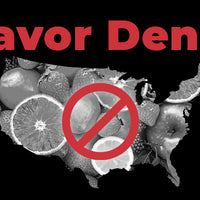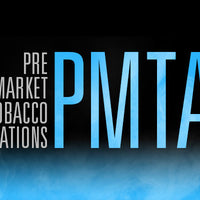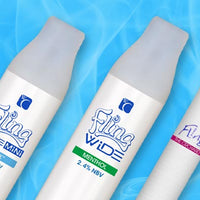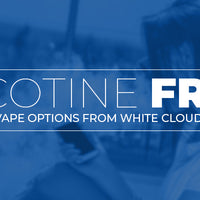Now that the FDA has authority to regulate vapor products as tobacco products, all vapor products that entered the market after the set grandfather date of February 15, 2007, are required to enter the FDA’s regulatory approval process to remain on the market. This process is known as the Premarket Tobacco Application Process (PMTA), which was implemented with the Tobacco Control Act in 2009.
This remains one of the biggest concerns in how the process will affect the vaping industry as a whole and is why the guest speakers of our DeMISTified Webinar Series received tons of questions regarding the PMTA process. Below you will find those questions with answers from the industry experts.
What are PMTAs?

The Premarket Tobacco Application (PMTA) requires all vapor products introduced to the market after the grandfather date of February 15, 2007, to enter a lengthy and quite costly FDA approval process. Manufacturers will have two years from the August 8th date to complete a PMTA for each product and submit it to the FDA.
Manufacturers who submit a PMTA in that time frame will be able to stay on the market for an additional year, depending on when the FDA rules on their PMTA. If the FDA denies an application before that additional year is up, the manufacturer or retailer would have to remove the product from the market. Since the effective date of the regulations is August 8, 2016, no new e-cigarette products can be introduced to the market without completing the PMTA process to obtain FDA approval.
From the FDA website:
“Premarket Tobacco Applications must provide scientific data to demonstrate that the new tobacco product is beneficial to the population as a whole, including users and non-users. This demonstration shall take into account the increased or decreased likelihood that existing tobacco users will stop using such products, and the increased or decreased likelihood that those who do not use tobacco products will start using them.”
How Will the Costs of PMTAs impact the industry?
There is no exact cost affixed to creating a PMTA. Estimates have ranged from $300k to millions of dollars. However, one thing is certain, even if the lowest estimates are correct, the PMTA process will immediately change the landscape of the industry. With so many small businesses in the industry, many manufacturers will be unable to meet the financial burden of the process, especially with no guarantee of approval. Not to mention the high financial cost and overwhelming burden of the scientific reporting requirements will surely push the smaller manufacturers and vape shop owners out of the market.
What are the scientific burdens of PMTAs?
The PMTA must demonstrate the proposed product is beneficial not only for the user, but for society as a whole. It is one thing to analyze and report on the physical impact of a product on its user, but it is another matter entirely to create a report on the societal impact of a product. The burden of creating a report that will address the seemingly unquantifiable likelihood of a product’s effect on the future actions of people exposed to it is unknown at this time. This requirement creates a level of reporting that can be costly beyond the abilities of many manufacturers.
What is the history of PMTAs being approved?
Since the implementation of the PMTA process passed with the Tobacco Control Act of 2009, only one group of tobacco products has received FDA approval. Swedish Match received approval for 8 of their Snus products in November of 2015. Their successful application was accompanied by their Modified Risk Application consisting of over 100,000 pages and supported by over 100 years of epidemiology.
Will manufacturers be able to continue selling products during the PMTA process?
The short answer is yes: manufacturers can continue selling their products during the PMTA process. However, they cannot sell them indefinitely. Manufacturers will have two years from the active date of the regulations, August 8th, 2016, to submit their PMTAs. After submitting a PMTA, a manufacturer can continue selling their products for an additional year. However, if the FDA declines their PMTA application before that time is up, the manufacturer will be required to discontinue selling their product.
What are the costs of the PMTA applications? Where are the estimate costs of the PMTA coming from?
PMTA cost estimates are all over the board: the FDA suggests the cost will be in the $150k to $300k range, whereas opponents have the cost running into the millions. The extensive reporting required for the PMTA creates a situation where estimating the total cost becomes difficult to pinpoint. One of the reasons we see such wildly divergent estimates is that no vapor device or e-liquid has gone through the PMTA process, so there is no example to draw from.
How much will it cost to get a new SKU/Product through the PMTA process?
Cost estimates for the PMTA process vary significantly, from the hundreds of thousands to the millions. With no vapor product having gone through the process, it is almost impossible to affix an exact number to what the cost will be per product. The FDA’s PMTA cost estimates can be found here beginning on page 86.
What form of support is offered for smaller manufacturers?
In addition to having additional time for smaller manufacturers to meet regulatory compliance, the FDA will offer further assistance with their PMTAs, including an appointed regulatory manager. The manager will create a dedicated contact in the FDA’s Center for Tobacco Products (CTP) Office of Science to answer questions and offer an appeal process for declined PMTAs. The CTP Office of Compliance and Enforcement will also assist small-scale tobacco product manufacturers in navigating the regulatory requirements of the PMTAs.
When the Family Smoking Prevention and Tobacco Control Act (FSPTCA) was signed into law in 2009, it authorized the FDA to collect user fees from tobacco manufacturers. These user fees were used by the FSPTCA to create the FDA’s Center for Tobacco Products (CTP) and continue to be the source of funding. Since vapor products are now deemed as tobacco products, the manufacturers of these products will be responsible for the appropriate user fees.
For additional information, check out this page.
What are the modified risk claims? How do they affect the vapor industry?
A modified risk claim is part of the Modified Risk Tobacco Product Application (MRTPA). Modified risk tobacco products (MRTPs) are “tobacco products that are sold, distributed, or marketed with a claim to reduce harm or the risk of tobacco-related disease”. Vapor product manufacturers must submit an MRTPA in order to claim a product has less risk or is less harmful than another tobacco product. Without FDA approval, e-cig manufacturers cannot claim their products are safer than any other tobacco product.
How long will a manufacturer be able to keep products on shelves if they can't comply with FDA regulations?
Vapor product manufacturers have two years from August 8th, 2016, to submit their PMTAs, during which they can continue selling a product. Applying for a PMTA grants an additional year to continue selling the product while the FDA reviews the application. However, the FDA can rule on an application before that year is up and the manufacturer will be required to remove the product from the market if the PMTA is denied. If e-cig manufacturers have no intention of filing a PMTA, they can continue selling for two years after the August 8th effective date–filing a PMTA grants the third year.






